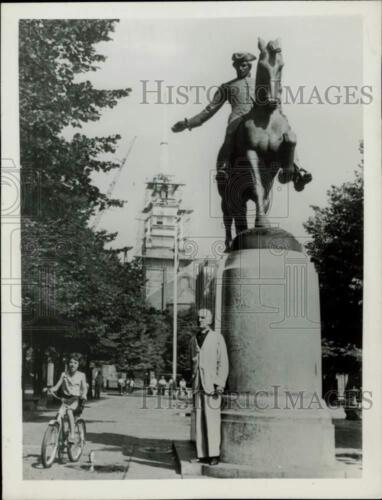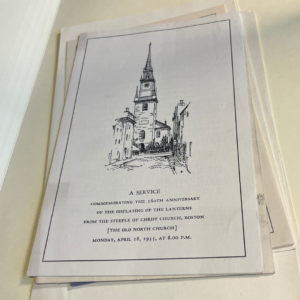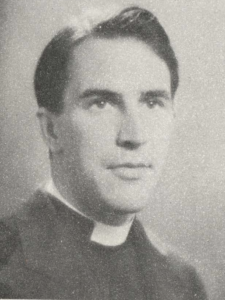The Two Episcopal Vicars Who Led Old North During Its Steeple Rebuilding Campaign, 1954-1956
Join us for a two-part blog series based on research by Fall 2022 Old North Illuminated Research Intern, Lee Parker. In part one, you learned about the people who contributed to helping the Old North Church rebuild its steeple after Hurricane Carol felled it in 1954. You discovered how efforts to rebuild the famed steeple catapulted the church into the national debate about stopping the spread of Communism, defending civil liberties, and historical memory.
Now, in part two, you will meet the Episcopal vicars (ministers) Rev. Charles Peck and Rev. Howard Kellett who served the Old North Church during the steeple fundraising campaign. Learn how they felt about some of the political concerns of the 1950s and what they did to lead Old North through a period of uncertainty.
Meet Rev. Charles Peck

Charles Russell Peck became the vicar of the Old North Church in 1946. During his tenure at Old North, Hurricane Carol felled the church’s steeple. Like his predecessors at Old North, Peck knew the significance of the church’s steeple within the history of the American Revolution. As Old North’s ministers had done since 1923, he presided over an annual April worship service in which the church celebrated its long history in Boston and the anniversary of “the hanging of the Paul Revere lanterns.”
On April 18, 1954, the congregation hosted its annual lantern service to celebrate the 179th anniversary of the lantern signals from the church’s steeple. The service program explained that the church was “open every day of the year” and that visiting hours were from 10 am until 4 pm daily. The program further boasted that the church had continuously held Sunday services since 1723, “except for interruptions during the Revolution.” 1 The service included music from the eighteenth, nineteenth, and twentieth centuries, including the hymn “Love Divine, All Loves Excelling,” by Charles Wesley, prolific hymn-writer, Anglican priest, and co-founder of the Methodist Society, who preached at Old North in 1736.2 The congregation also sang the hymn “America” while Revere Little, a Paul Revere descendant, carried the lanterns into the tower. The patriotic hymn was penned in 1831 by Dr. Samuel F. Smith, whom the program explains had lived in the North End. The program reflected the church’s pride in its history and its ongoing desire to share its history with those who visited daily.

The Monday, April 18, 1955 lantern service happened as planned, but the program reflected the crisis the church faced. The program explained that the hurricane of August 31, 1954, “made many changes here.”3 Pictures of the falling steeple had appeared in The London Times, the Paris Herald, and German and Austrian newspapers. People from all over the country donated funds to help with rebuilding the steeple, but as of April 1955, the goal had not been reached. Although they hoped the steeple would rise again, the congregation was considering the possibility of a “church other than bricks and mortar.”
Although the congregation was devastated by its loss, Peck’s 1971 obituary indicates that he understood the importance of rebuilding the steeple. It notes that he postponed his retirement so he could help the church with its fundraising efforts.4
Meet Rev. Howard P. Kellett

Howard Pearson Kellett succeeded Peck as the vicar of Old North in 1955. By the time he began as vicar, Peck had overseen most of the fundraising campaign for the third steeple, but it was reconstructed under Kellett’s leadership. Before he became the vicar at Old North, Kellett served as the chaplain at the Charlestown prison.
At Old North, he had the same passion for reform that characterized his prison ministry. He, like his predecessor, understood that Old North’s history was part of its ministry in Boston, but he framed the church’s history as one of inclusion. In his undated sermon, “Prayer for our Country,” Kellett went so far as to assert that Black congregants did not have segregated seating in Old North’s sanctuary in the colonial period. Kellett preached, “Timothy Cutler [the church’s first rector] . . . to his everlasting credit . . . welcomed all men here, led and stimulated people to think, and the result, all men in their needs were helped.” He continued on to say that from the church’s earliest days, all people were treated equally. He explained that “from time to time, individuals have been prone to say that a section was reserved for negroes in the balcony. In studying the many records of the church, I have not come upon any records to sustain such a statement. On the contrary, with the purchase of free pews and the erection of more in the balcony, all evidence indicates that they were meant to be free and for all men.” 5 Kellett’s revisionist history of seating at Old North is, at worst, an attempt to distance the church from its historical connections to Atlantic world slavery, and at best, an attempt (albeit a dishonest one) to connect the church to the civil rights movements of the 1950s, which Kellett supported.
Both before and during his career at Old North Church, Kellett was closely involved with the ACLU. He used his position at Old North Church to express his progressive views. His dedication to preserving the connection between civil liberties and rights to the revolutionary founding of the United States and his desire to use this connection against the suppression of these civil liberties based on race is evident in the assistance he provided in the drafting of the memorandum on racial discrimination put together by the Department on Social Relations and the Social Action Committee of the Massachusetts Council on Churches in 1958. Kellett and other individuals associated with the Massachusetts Council on Church wrote that they believed residential segregation caused barriers to church integration. Furthermore, they supported recent Supreme Court decisions that declared racial segregation unconstitutional. They asserted that such decisions supported “the Christian teachings of the divinity of all men under God.”6
Conclusion
Charles Peck and Howard Kellett served the Old North Church during a time of uncertainty, both for the church and the nation. Under Peck’s leadership, the congregation celebrated its long history and connection to the American Revolution. The church became a popular historic site that welcomed visitors daily. The structural damage to the church during Hurricane Carol changed the nature of Peck’s ministry. Through his fundraising efforts, he alerted the nation and the world that Old North’s steeple represented American freedoms. As the Cold War was at its height, the fundraising efforts happened at a time of heightened political crisis in the United States. As the United States found its footing during a global standoff, many Americans sought to define what it meant to be American. Some linked their patriotism to their religion.
Howard Kellett offered the church a different type of leadership than Peck did. As the steeple was rebuilt, Kellett reimagined the church as a place that had always been inclusive of all people, regardless of their race. He, like Henry Wadsworth Longfellow, was committed to a more inclusive version of American history, and Old North’s historic steeple was his inspiration. Although his historical memories of Old North were inaccurate, they captured the spirit of Civil Rights leaders at the time, including Rev. Dr. Martin Luther King Jr., who, inspired by Longfellow’s poem, said in 1967, “We still need some Paul Revere of conscience to alert every hamlet and every village of America that revolution is still at hand.”7 As they oversaw the reconstruction of the historic steeple and led the congregation through years of political tumult, both Peck and Kellett aimed to be men of conscience who alerted the nation that a revolution was still at hand.
End Notes
1. A Service Commemorating the 179th Anniversary of the Displaying of the Lanterns from the Steeple of Christ Church, Boston [The Old North Church] Sunday, April 18, 1954, at 8:00 pm,” Box 43, Folder 31 Old North Lantern Service Programs, 1950-1954, Massachusetts Historical Society.
2. Wesley led worship with Old North’s first rector in 1736 when he was en route back to England.
3. A Service Commemorating the 180th Anniversary of the Displaying of the Lanterns from the Steeple of Christ Church, Boston [The Old North Church] Monday, April 18, 1955, at 8:00 pm,” Box 43, Folder 31 Old North Lantern Service Programs, 1950-1954, Massachusetts Historical Society.
4. “Rev. Charles Peck, Vicar Emeritus, 82,” New York Times, April 15, 1971. https://www.nytimes.com/1971/04/15/archives/rev-charles-peck-vicar-emeritus-82.html.
5. Prayer for our country, box 28.
6. “Resolutions 159th Annual Meeting, May 19-21, 1958 ” created by the American Civil Liberties Union of Massachusetts, 19-21 May 1958, MS.N-2257, carton 14 folder “MASS Council on Churches January-April 1958”, American Civil Liberties Union of Massachusetts Records, Massachusetts Historical Society, Boston, MA.
7. Mailing Address: 105 Brattle Street Cambridge and MA 02138 Phone:876-4491 Contact Us, “Paul Revere’s Ride – Longfellow House Washington’s Headquarters National Historic Site (U.S. National Park Service),” https://www.nps.gov/long/learn/historyculture/paul-reveres-ride.htm.
